
Somehow you always end up talking about fire in Australia, especially if you spend a lot of time outdoors like we do.
Locals refer to certain years as familiar, but horrific signposts from the past. 2009 in the Melbourne area. 2007 on Kanaroo Island. 1935 or 2006 in the Southwest Forest of Tasmania. 2013 on the Tasman Peninsula. And perversely there are the great flood years in other parts, like this year in Queensland.
January and February are the most dangerous time for fires to erupt here. These are the hot dry months. Grasses and ground cover turn the pale yellow of dry hay, as on the ranches outside Los Angeles or the plains of Texas in summer; bushes gain a dusty pallor. Storms bring lightning to scorch the land, but not much rain. And this is true on the island of Tasmania – which we are currently touring – as well as the desert areas of drought-plagued mainland Australia, even though Tasmania has great rivers and wetlands that are fed plentifully from its modest snowfall and underground springs.
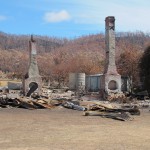
This past January, fires had struck huge tracts of land on the island; you could see torched fields and forests from the road, and even the airport still smelled of smoke due to the remnants of a burn on a set of hills nearby. These are frightening phenomena. Near Copping, just north of the Tasman Peninsula, we passed acres and acres of land burnt by a fire that swept across 60 kilometers in just two days, leaping over a wide bay of water to continue its raging. Homes were flattened, with ironically just their chimneys standing afterwards. But occasionally, miraculously, some homes near them were spared as the fires swirled around according to their own horrific logic. One landowner told us that his untouched house survived from 80% luck and 20% deliberate action, as his neighbors knocked down water tanks to drench the land, and by hosing down the house, as the fire rampaged over the nearby hill. He and his family survived, he said, only by diving into the bay as the fire vaulted over their heads to the far banks.
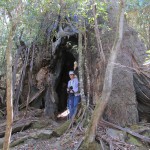
Far from this recent devastation, we walked the forests of the reserve lands above the Huon River valley in southern Tasmania. We saw the gums (eucalyptus), myrtle trees, beech, sassafras, pines and the mature fern trees of the island forests in areas untouched by fire for decades. Majestic sugar gums towered over all of these, rivalling the height and size of redwoods. Moss seemed to cover everything, especially the many trees felled by fire or lightning or age, whose decay gives life to the rest. Wallabies and diverse native birds appeared plentiful. Some trees showed the effects of long-ago fires in hollowed or damaged trunks.
In the open areas, however, we saw the aftermath of fires from six years ago, with ferns and bushes barely three foot high, hay like grasses, the gums just sprouting leaves and branches anew. At overlooks, across huge plots of land, we could see as well a greenish forest floor out of which so many stricken, barren, white-stalked trees poked up. Deeper into the valley, where farmland had displaced native plants, all was yellow. Up higher with us, life was regaining its foothold.
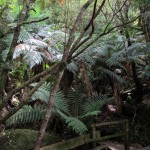
Before the Europeans arrived, the aborigines understood that the fertility of the land benefited from fires. They would deliberately burn areas to control plant growth, fertilize the land and ensure that naturally occuring fires would be manageable. They recognized how the response by native plants to fire shaped the landscape they lived in. Fern trees would naturally settle in the cooler, damper gulleys of the forests in order to protect themselve against fire.

The native gum tree so useful to wildlife and full of uses as timber is able to survive strong fires and, within a few years, flourish again. In recent fire-stricken areas, a black carbon band encircles the lower trunks of the gums while the remotely high branches continue to leaf.

And our favorite plant, the Banksia marginata (what they call a honeysuckle) needs fire to spread its seeds. The flower looks like a bright yellow toilet brush, but dies as a grey hairy core like a pine cone. Inside this ugly thing rest the seeds that fire releases to form new Banksias.
The problem though is that fire has become the enemy as descendants of European settlers have planted trees and crops that fire destroys and have not adapted to fire. They have moved onto hilltops and farmed areas prone to trouble.

Though fire has long shaped and impacted life here, we’ve seen how native plants have also responded to a very different ecology based on water and cold, and presented similar lessons on adapting and surviving. Another hike took us to Hartz Mountain, a bit farther south. At an altitude of 3000 feet or so, we walked in a startlingly different subalpine environment, made fertile by springs and snowfall. Here cold and inclemency for much of the year are the perils that breed much different, but equally resilient plant life unaffected by non-native intrusions.
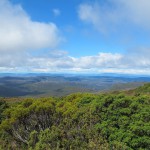
Even in the summer, they warn you, wintry conditions can hit suddenly. Below us the valley and shore were sunlit, while mists, fog and rain hit us regularly up high.

Myriad plants flourished in a bog-like terrain that could only be walked via an 8 kilometer boardwalk built for accessibility by the forest service.
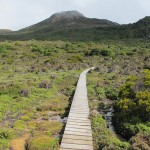
Rich green colors spread across the damp land around us. Tiny flowers peeked out of bushes in the wet conditions, presenting specks of peach, pink, red, white if you looked closely. Some complex, but millimeter-leafed plants clustered densely together to share warmth against the coldest conditions. On the hillsides, thickets of stunted trees shared the same defensive strategy.
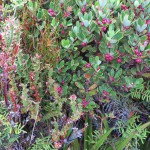
Harness your strengths in reserve so that you can use a catastrophe to prosper, says the Banksia marginata to us from the dry places. Know your limits but grow collectively with others, say all those survivors of icy blasts on Hartz Mountain. To us, they give good advice for handling financial matters, thriving in society or even more spiritual pursuits. Walking the trails of the Hartz Mountains and the Huon Valley gave us a lot more than exercise: life lessons to ponder from Tasmanian plants.
(Also, for more pictures from Australia, CLICK HERE to view the slideshow at the end of the Australia itinerary page.)



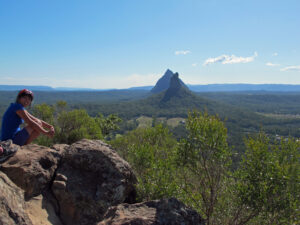
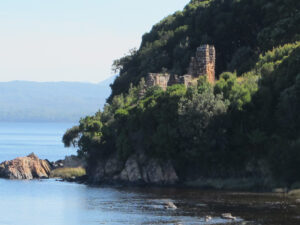
WOW looks amazing!